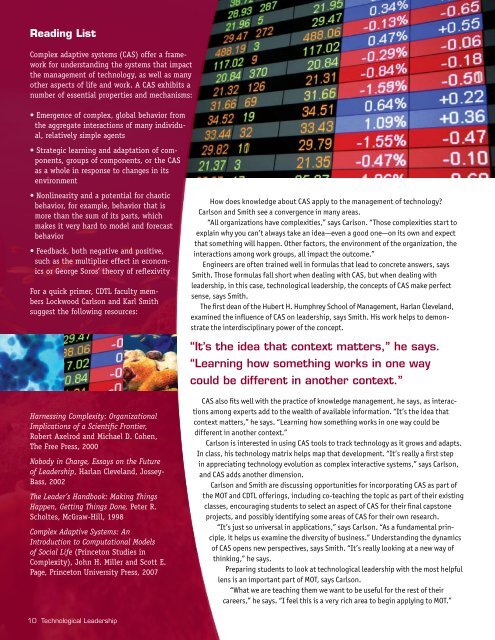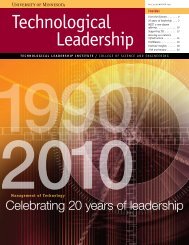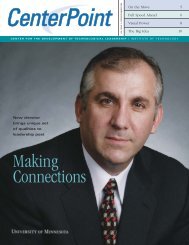Critical - Technological Leadership Institute - University of Minnesota
Critical - Technological Leadership Institute - University of Minnesota
Critical - Technological Leadership Institute - University of Minnesota
You also want an ePaper? Increase the reach of your titles
YUMPU automatically turns print PDFs into web optimized ePapers that Google loves.
Reading List<br />
Complex adaptive systems (CAS) <strong>of</strong>fer a framework<br />
for understanding the systems that impact<br />
the management <strong>of</strong> technology, as well as many<br />
other aspects <strong>of</strong> life and work. A CAS exhibits a<br />
number <strong>of</strong> essential properties and mechanisms:<br />
• Emergence <strong>of</strong> complex, global behavior from<br />
the aggregate interactions <strong>of</strong> many individual,<br />
relatively simple agents<br />
• Strategic learning and adaptation <strong>of</strong> components,<br />
groups <strong>of</strong> components, or the CAS<br />
as a whole in response to changes in its<br />
environment<br />
• Nonlinearity and a potential for chaotic<br />
behavior, for example, behavior that is<br />
more than the sum <strong>of</strong> its parts, which<br />
makes it very hard to model and forecast<br />
behavior<br />
• Feedback, both negative and positive,<br />
such as the multiplier effect in economics<br />
or George Soros’ theory <strong>of</strong> reflexivity<br />
For a quick primer, CDTL faculty members<br />
Lockwood Carlson and Karl Smith<br />
suggest the following resources:<br />
How does knowledge about CAS apply to the management <strong>of</strong> technology<br />
Carlson and Smith see a convergence in many areas.<br />
“All organizations have complexities,” says Carlson. “Those complexities start to<br />
explain why you can’t always take an idea—even a good one—on its own and expect<br />
that something will happen. Other factors, the environment <strong>of</strong> the organization, the<br />
interactions among work groups, all impact the outcome.”<br />
Engineers are <strong>of</strong>ten trained well in formulas that lead to concrete answers, says<br />
Smith. Those formulas fall short when dealing with CAS, but when dealing with<br />
leadership, in this case, technological leadership, the concepts <strong>of</strong> CAS make perfect<br />
sense, says Smith.<br />
The first dean <strong>of</strong> the Hubert H. Humphrey School <strong>of</strong> Management, Harlan Cleveland,<br />
examined the influence <strong>of</strong> CAS on leadership, says Smith. His work helps to demonstrate<br />
the interdisciplinary power <strong>of</strong> the concept.<br />
“It’s the idea that context matters,” he says.<br />
“Learning how something works in one way<br />
could be different in another context.”<br />
Harnessing Complexity: Organizational<br />
Implications <strong>of</strong> a Scientific Frontier,<br />
Robert Axelrod and Michael D. Cohen,<br />
The Free Press, 2000<br />
Nobody in Charge, Essays on the Future<br />
<strong>of</strong> <strong>Leadership</strong>, Harlan Cleveland, Jossey-<br />
Bass, 2002<br />
The Leader’s Handbook: Making Things<br />
Happen, Getting Things Done, Peter R.<br />
Scholtes, McGraw-Hill, 1998<br />
Complex Adaptive Systems: An<br />
Introduction to Computational Models<br />
<strong>of</strong> Social Life (Princeton Studies in<br />
Complexity), John H. Miller and Scott E.<br />
Page, Princeton <strong>University</strong> Press, 2007<br />
CAS also fits well with the practice <strong>of</strong> knowledge management, he says, as interactions<br />
among experts add to the wealth <strong>of</strong> available information. “It’s the idea that<br />
context matters,” he says. “Learning how something works in one way could be<br />
different in another context.”<br />
Carlson is interested in using CAS tools to track technology as it grows and adapts.<br />
In class, his technology matrix helps map that development. “It’s really a first step<br />
in appreciating technology evolution as complex interactive systems,” says Carlson,<br />
and CAS adds another dimension.<br />
Carlson and Smith are discussing opportunities for incorporating CAS as part <strong>of</strong><br />
the MOT and CDTL <strong>of</strong>ferings, including co-teaching the topic as part <strong>of</strong> their existing<br />
classes, encouraging students to select an aspect <strong>of</strong> CAS for their final capstone<br />
projects, and possibly identifying some areas <strong>of</strong> CAS for their own research.<br />
“It’s just so universal in applications,” says Carlson. “As a fundamental principle,<br />
it helps us examine the diversity <strong>of</strong> business.” Understanding the dynamics<br />
<strong>of</strong> CAS opens new perspectives, says Smith. “It’s really looking at a new way <strong>of</strong><br />
thinking,” he says.<br />
Preparing students to look at technological leadership with the most helpful<br />
lens is an important part <strong>of</strong> MOT, says Carlson.<br />
“What we are teaching them we want to be useful for the rest <strong>of</strong> their<br />
careers,” he says. “I feel this is a very rich area to begin applying to MOT.”<br />
10 <strong>Technological</strong> <strong>Leadership</strong>








